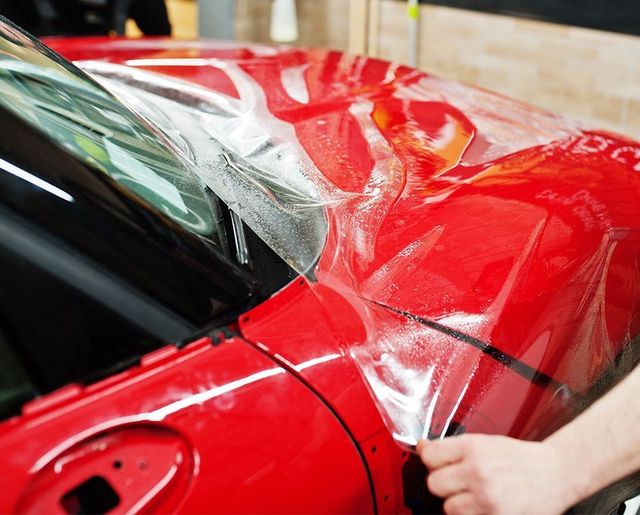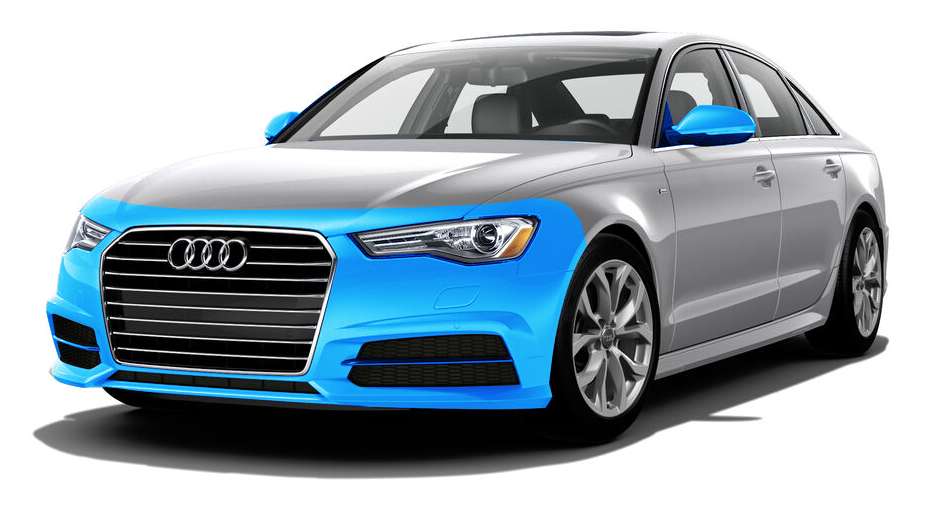The Ultimate Guide to Recognizing Paint Protection Film for Automobile Fanatics
Paint Protection Film (PPF) has actually ended up being an important topic amongst automobile fanatics seeking to preserve their car's look. This advanced protective layer supplies countless advantages, from protecting against ecological risks to preserving resale value. Comprehending the different sorts of PPF, the application process, and maintenance tips can greatly impact one's investment. Yet, many misconceptions persist. What are the most common myths, and how do they contrast to various other protective options?
What Is Paint Protection Film (PPF)?
Paint Protection Film (PPF) functions as a transparent shield for vehicle surface areas. This sophisticated polyurethane material is created to adhere effortlessly to a lorry's exterior, providing a safety layer against different ecological threats. PPF is commonly used to high-impact areas, such as hoods, bumpers, and mirrors, where scratches and chips are most likely to occur.The movie is remarkably durable, using resistance against UV rays, roadway particles, and chemical stains, which can deteriorate a lorry's surface over time. Its self-healing buildings enable small scrapes to go away with warm direct exposure, keeping a spotless appearance. PPF is available in various surfaces, consisting of gloss and matte, to match various paint designs and preferences.Installation requires precision, commonly best done by professionals to assure a remarkable application. In General, Paint Protection Film is an ingenious solution for auto fanatics seeking to maintain their lorry's visual appeal while protecting its surface area stability.
Advantages of Using Paint Protection Film
While lots of cars and truck enthusiasts prioritize aesthetic appeals, the practical benefits of Paint Protection Film (PPF) are equally engaging. PPF functions as a durable obstacle against numerous environmental risks, including road particles, stone chips, and insect stains, properly preserving the car's exterior. In addition, it offers UV protection, preventing paint from fading and maintaining the automobile's dynamic shade over time.Another considerable benefit is the self-healing properties of innovative PPFs, which can recuperate from small scrapes and swirl marks with heat direct exposure, ensuring the surface continues to be immaculate. Installment of PPF can also boost resale value; prospective buyers are usually brought in to well-maintained vehicles with no noticeable flaws. PPF is simple to tidy and requires minimal maintenance, permitting car fanatics to appreciate their lorries without the tension of constant maintenance. In general, PPF integrates capability with aesthetic appeals, making it a sensible financial investment for car connoisseurs.
Different Kinds Of Paint Protection Film
Comprehending the various kinds of paint protection film is essential for automobile fanatics. Trick features such as self-healing innovation, comparisons of thickness and durability, and application strategies play a crucial role in selecting the right option. Each kind provides unique benefits that cater to various requirements and preferences.
Self-Healing Technology Explained
Self-healing modern technology revolutionizes the means vehicle enthusiasts secure their cars from square one and small damage. This ingenious feature is mainly located in innovative paint security films (PPF) When subjected to heat from sunlight or a warm environment, the distinct polymers within these films soften, permitting small scratches and swirl marks to "heal" themselves. This self-repairing ability not just preserves the movie's visual allure however also prolongs its safety high qualities. Various brands offer different solutions of self-healing movies, each with distinctive attributes tailored to details demands. Automobile enthusiasts value this technology for its capability to keep their vehicles looking excellent, minimizing the regularity of repair services and ensuring a longer-lasting protective remedy against daily wear and tear.

Thickness and Longevity Comparison
Density and sturdiness are crucial variables when examining various types of paint security film (PPF) PPF typically varies in thickness from 6 mils to 12 mils, with thicker movies using boosted resistance to scrapes, chips, and environmental damages. Thinner films, while less safety, often provide much better clarity and conformability, making them ideal for detailed designs and curves. Durability differs among brands and types; some films include advanced products that improve their life-span and preserve their appearance in time. In addition, self-healing buildings in particular PPF kinds can further extend long life by permitting minor scratches to vanish with warm. Ultimately, the option of density and durability need to straighten with the specific needs and preferences of the auto enthusiast.
Application Techniques Introduction
Selecting the right application method is crucial for maximizing the benefits of paint defense film (PPF) There are different approaches offered, each matched to various preferences and skill degrees. The most common methods consist of the conventional damp application, which uses a slip solution to assist in positioning, and the completely dry application, which needs precision and experience for immediate bond. Additionally, progressed alternatives like pre-cut kits supply comfort, made to fit certain car versions, while mass film enables customization yet requires more knowledge (SpeedEFX Paint Protection Film). Each technique offers special advantages and difficulties, making it crucial for car enthusiasts to select one that aligns with their objectives and abilities, ultimately making certain excellent security for their vehicles
The Application Refine of PPF
The application procedure of paint security film (PPF) involves several critical steps to ensure perfect results. Initially, comprehensive surface prep work is vital, adhered to by particular installment methods that optimize adhesion and coverage. Ultimately, appropriate post-application treatment is required to preserve the film's stability and look over time.
Surface Prep Work Steps
Correct surface area prep work is crucial for a successful paint protection film (PPF) application, as it directly impacts the movie's adhesion and durability. The first step entails completely washing the car to remove dust, gunk, and various other contaminants. A pH-neutral vehicle soap is advised to prevent harming the paint. Adhering to the laundry, the surface area needs to be dried carefully with microfiber towels to stop water areas. Next, any kind of existing flaws, such as scrapes or swirls, must be resolved, usually making use of a polish or compound. The surface ought to be wiped down with an isopropyl alcohol remedy to ensure it is entirely clean and totally free from oils or deposits. This precise prep work lays the foundation for a successful PPF installment.
Installment Methods Discussed
Understanding the application procedure of paint defense film (PPF) is important for accomplishing the ideal results. The setup typically begins with accurate measurements of the vehicle's surface areas to assure correct coverage. Tidiness is critical; the surface needs to be devoid of dirt, dirt, and pollutants. An installer usually makes use of a slip remedy, which helps with placing the movie during application.The film is meticulously laid onto the surface area, using devices like mops to remove air bubbles and excess option. Warmth may be put on adhere the movie to complicated curves and contours. Appropriate positioning and tension are essential for a smooth coating. Cutting excess film ensures a tidy edge, completing the installment procedure properly and improving the lorry's looks and defense.
Post-Application Treatment Tips

Maintenance Tips for Long-Lasting Protection
How can car fanatics assure their paint security film stays reliable like this gradually? Regular upkeep is important to secure the film's durability and efficiency (SpeedEFX Paint Protection Film). To start with, washing the vehicle with a pH-balanced automobile shampoo helps stop the build-up of contaminants that might damage the film. Making use of a microfiber towel for drying is advised to avoid scratches.Additionally, it is vital to avoid rough cleansing tools or severe chemicals, which can weaken the movie's surface area. Applying a sealer or wax especially designed for paint defense movie can supply an added layer of defense against UV rays and ecological elements.Furthermore, enthusiasts should consistently examine the film for any indications of wear or damage, attending to concerns quickly to maintain its safety qualities. Parking in shaded locations or utilizing cars and truck covers can also lessen exposure to hazardous UV rays. By adhering to these maintenance pointers, car fanatics can guarantee their paint defense film continues to be effective for years
Common Myths Regarding Paint Protection Film
What misunderstandings border paint defense film that car lovers should be conscious of? One prevalent myth my company is that paint defense movie (PPF) makes a vehicle look unpleasant or yellow in time. In truth, premium PPF is designed to remain clear and preserve its appearance. One more usual belief is that PPF is only required for new autos; however, any car can take advantage of this protective layer, no matter of age. Some enthusiasts also assume that PPF is also costly; while it might call for an upfront financial investment, the lasting financial savings on paint fixings can counter initial prices. In addition, lots of assume that PPF is a do it yourself project, however professional installation assurances appropriate positioning and adhesion, maximizing efficiency. Finally, there is a mistaken belief that PPF is not resilient, yet improvements in technology have actually made modern-day films immune to scratches, discolorations, and UV damage, providing reliable defense for years.
Contrasting PPF to Various Other Protection Options
Recognizing the different options readily available for car protection is essential for automobile enthusiasts who intend to keep their lorry's appearance. Paint Protection Film (PPF) is usually contrasted to wax, ceramic finishes, and traditional sealers. While wax uses a short-lived sparkle and basic defense, it normally calls for regular reapplication and supplies restricted sturdiness. Ceramic finishes supply improved defense versus UV rays and chemical discolorations, yet they can be a lot more pricey and require specialist application.PPF sticks out because of its robust defense versus physical damages, such as scratches and rock chips. Unlike wax or sealants, PPF is a lasting solution that can withstand extreme conditions without deteriorating. Furthermore, PPF can self-heal from small abrasions, maintaining its clarity and safety high qualities. In general, while each alternative has benefits, PPF is commonly preferred for its unmatched protection and longevity, making it a suitable selection for serious vehicle lovers.
Regularly Asked Inquiries
The Length Of Time Does Paint Protection Film Last on an Automobile?
The longevity of paint defense film on a car usually ranges from 5 to 10 years, depending upon elements such as ecological conditions, upkeep techniques, and the quality of the movie used throughout application.
Can PPF Be Eliminated Without Harming the Auto's Paint?
The elimination of paint protection film (PPF) can be done thoroughly, usually without damaging the automobile's paint. SpeedEFX Paint Protection Film. The procedure calls for correct strategies and devices to ensure the underlying surface stays intact and undamaged.
Is PPF Installment a DIY Project or Ideal Left to Professionals?
The inquiry of whether paint protection film (PPF) setup appropriates for do it yourself lovers or best handled by specialists usually occurs. Many experts advise specialist installment to guarantee perfect adherence and avoid prospective damages during the process.
Does Paint Protection Film Impact the Vehicle's Resale Worth?
The impact of paint protection film on an auto's resale value differs. While it can enhance look and secure versus damage, potential purchasers might have blended feelings, valuing the next page film differently based upon their choices and experiences.
Can PPF Be Applied Over Existing Scrapes or Chips?
Using paint security movie (PPF) over existing scrapes or chips is generally not recommended. Blemishes might intensify in time, and appropriate surface preparation is necessary for optimal attachment and long life of the movie's safety top qualities.